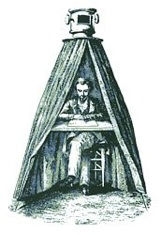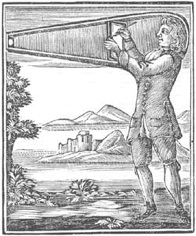Click on Play/Pause to proceed along Time line


Many have contributed to the evolution of the camera obscura. The principle was known as early as c. 400 BC by the Chinese Mohists and c. 350 BC by Aristotle. Both knew of the linearity of light and the formation of an inverted image when light passed through a small hole.
It was not until over a thousand years later that Alhazen an Arabian scholar, described the principle in detail and applied it to the viewing of eclipses. This was used by Roger Bacon who in 1267 referred to the formation of images from eclipses and from scenes outside a darkened room.
An image formed this way is not bright or sharp. Increasing the hole size makes the image definition worse. However ,when a convex (converging) lens is used, the image becomes brighter because more light passes through the larger diameter and the image can be focussed sharply on a screen.
Development moved much faster in the 16th century. In 1545 Gemma Frisius published the first illustration of a camera obscura which he had used to observe a solar eclipse. Girolama Cardano in 1550 was the first to mention the use of a lens in place of a small hole, followed by Giovanni Battista Della Porta in 1558 who perfected the camera obscura using a convex lens and a mirror to get an erect image. A description by Daniel Barbaro in 1568 suggested the use of a diaphragm to improve focussing.
At this point in its history the camera obscura has all the attributes of a photographic camera apart from the shutter and of course the ability to record permanent images. Interestingly, there is a magical aspect to the use of camera obscuras. Villeneuve a physician and magician in 1290 and Cardano some two hundred and fifty years later entertained audiences inside darkened rooms by ‘conjuring up’ moving pictures of acting outside the room. The images would be seen on a wall inside the room, synchronous with the external sound.
During the 17th c. developments continued with portable camera obscuras by Robert Boyle and Robert Hooke ( a contemporary of John Aubrey - click on ‘Exhibition’ ) including a collapsible tent form by Kepler in 1620.
The scioptric ball was yet another form - a lens in a universal joint mounted in a window shutter which could be swivelled to give panoramic views of the outside. The portable types were very popular with artists and travellers, enabling accurate perspective drawings and outlines to be achieved. Several famous artists have used camera obscuras - Canelletto, Joshua Reynolds,Paul Sandby and reputedly Vermeer . David Hockney in his book ‘Secret Perspectives’ puts forward the thesis that from the early 15th c. many Western artists used mirrors and lenses to create living projections. See video below.
The next significant improvement was not until John Dolland in 1758 used an achromatic lens ( created by combining crown and flint glass) to minimise colour distortion and then Wiliam Storer in 1778 patented ‘The Royal Accurate Delineator’ using an additional convex lens below the viewing screen to significantly brighten the image. The final improvement was by Chevalier a Parisian instrument maker who in 1825 replaced the mirror and lens system with a single meniscus prism. This is a right-angled prism which reflects the light internally focussing the image through its optically curved faces. This setup was used largely in tent camera obscuras.
A common form of permanent camera obscura , popular at the seaside and viewpoints enable viewers to stand in a darkened room where views of the outside are projected onto a white,horizontal screen. Usually the optics consist of a long focal length lens with a mirror at 45 degrees which can be rotated through 360 degrees giving views of the surroundings. For examples of these in continental Europe , click on Camera Obscuras ‘ . In the UK there are good examples at Clifton, Edinburgh and Foredown Tower, Sussex.
Finally the portable camera obscura was the platform used by Wedgewood , Fox Talbot, and Daguerre for securing a permanent image. Surfaces made sensitive to light using chemicals, replaced the viewing screen in the portable camera obscura creating the first photographic camera . Photography as we know it was then born in 1839.
A brief history of the development of camera obscuras



Typical 17th c. Camera Obscura
Camera Obscura by Hooke
Kepler’s Tent Camera Obscura

Chevalier’s drawing of a tent camera obscura showing the meniscus prism

